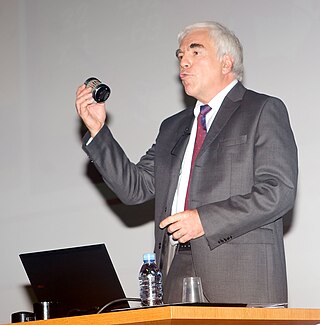Related Research Articles
Forth is a procedural, concatenative, stack-oriented programming language and interactive development environment designed by Charles H. "Chuck" Moore and first used by other programmers in 1970. Although not an acronym, the language's name in its early years was often spelled in all capital letters as FORTH. The FORTH-79 and FORTH-83 implementations, which were not written by Moore, became de facto standards, and an official standardization of the language was published in 1994 as ANS Forth. A wide range of Forth derivatives existed before and after ANS Forth. The free software Gforth implementation is actively maintained, as are several commercially supported systems.
OCaml is a general-purpose, high-level, multi-paradigm programming language which extends the Caml dialect of ML with object-oriented features. OCaml was created in 1996 by Xavier Leroy, Jérôme Vouillon, Damien Doligez, Didier Rémy, Ascánder Suárez, and others.

In computer science, an interpreter is a computer program that directly executes instructions written in a programming or scripting language, without requiring them previously to have been compiled into a machine language program. An interpreter generally uses one of the following strategies for program execution:
- Parse the source code and perform its behavior directly;
- Translate source code into some efficient intermediate representation or object code and immediately execute that;
- Explicitly execute stored precompiled bytecode made by a compiler and matched with the interpreter Virtual Machine.
Verilog, standardized as IEEE 1364, is a hardware description language (HDL) used to model electronic systems. It is most commonly used in the design and verification of digital circuits at the register-transfer level of abstraction. It is also used in the verification of analog circuits and mixed-signal circuits, as well as in the design of genetic circuits. In 2009, the Verilog standard was merged into the SystemVerilog standard, creating IEEE Standard 1800-2009. Since then, Verilog has been officially part of the SystemVerilog language. The current version is IEEE standard 1800-2023.
In computer engineering, a hardware description language (HDL) is a specialized computer language used to describe the structure and behavior of electronic circuits, most commonly to design ASICs and program FPGAs.
Lexical tokenization is conversion of a text into meaningful lexical tokens belonging to categories defined by a "lexer" program. In case of a natural language, those categories include nouns, verbs, adjectives, punctuations etc. In case of a programming language, the categories include identifiers, operators, grouping symbols and data types. Lexical tokenization is not the same process as the probabilistic tokenization, used for a large language model's data preprocessing, that encodes text into numerical tokens, using byte pair encoding.
In computer science and software programming, a value is the representation of some entity that can be manipulated by a program. The members of a type are the values of that type.
In computer science, a deterministic algorithm is an algorithm that, given a particular input, will always produce the same output, with the underlying machine always passing through the same sequence of states. Deterministic algorithms are by far the most studied and familiar kind of algorithm, as well as one of the most practical, since they can be run on real machines efficiently.
A synchronous programming language is a computer programming language optimized for programming reactive systems. Computer systems can be sorted in three main classes: (1) transformational systems that take some inputs, process them, deliver their outputs, and terminate their execution; a typical example is a compiler; (2) interactive systems that interact continuously with their environment, at their own speed; a typical example is the web; and (3) reactive systems that interact continuously with their environment, at a speed imposed by the environment; a typical example is the automatic flight control system of modern airplanes. Reactive systems must therefore react to stimuli from the environment within strict time bounds. For this reason they are often also called real-time systems, and are found often in embedded systems.
Lustre is a formally defined, declarative, and synchronous dataflow programming language for programming reactive systems. It began as a research project in the early 1980s. A formal presentation of the language can be found in the 1991 Proceedings of the IEEE. In 1993 it progressed to practical, industrial use in a commercial product as the core language of the industrial environment SCADE, developed by Esterel Technologies. It is now used for critical control software in aircraft, helicopters, and nuclear power plants.
Lola is designed to be a simple hardware description language for describing synchronous, digital circuits. Niklaus Wirth developed the language to teach digital design on field-programmable gate arrays (FPGAs) to computer science students while a professor at ETH Zurich.

Gérard Philippe Berry is a French computer scientist, member of the French Academy of Sciences, French Academy of Technologies, and Academia Europaea. He was the Chief Scientist Officer of Esterel Technologies from 2000 to 2009. He held the 2007-2008 yearly Liliane Bettencourt chair of Technological Innovation at the Collège de France. He was Director of Research at INRIA Sophia-Antipolis and held the 2009-2010 yearly Informatics and Digital Sciences chair at the Collège de France. Berry's work, which spans over more than 30 years, brought important contributions to three main fields:

Esterel Technologies is a supplier of model-based design, validation, and code generation tools for safety-critical software and hardware applications. Esterel's tools create formal specifications that produce control designs code in software and/or hardware.
Verilog-AMS is a derivative of the Verilog hardware description language that includes Analog and Mixed-Signal extensions (AMS) in order to define the behavior of analog and mixed-signal systems. It extends the event-based simulator loops of Verilog/SystemVerilog/VHDL, by a continuous-time simulator, which solves the differential equations in analog-domain. Both domains are coupled: analog events can trigger digital actions and vice versa.
Functional reactive programming (FRP) is a programming paradigm for reactive programming using the building blocks of functional programming. FRP has been used for programming graphical user interfaces (GUIs), robotics, games, and music, aiming to simplify these problems by explicitly modeling time.
Sawzall is a procedural domain-specific programming language, used by Google to process large numbers of individual log records. Sawzall was first described in 2003, and the szl runtime was open-sourced in August 2010. However, since the MapReduce table aggregators have not been released, the open-sourced runtime is not useful for large-scale data analysis of multiple log files off the shelf. Sawzall has been replaced by Lingo for most purposes within Google.

Reo is a domain-specific language for programming and analyzing coordination protocols that compose individual processes into full systems, broadly construed. Examples of classes of systems that can be composed with Reo include component-based systems, service-oriented systems, multithreading systems, biological systems, and cryptographic protocols. Reo has a graphical syntax in which every Reo program, called a connector or circuit, is a labeled directed hypergraph. Such a graph represents the data-flow among the processes in the system. Reo has formal semantics, which stand at the basis of its various formal verification techniques and compilation tools.
TNSDL stands for TeleNokia Specification and Description Language. TNSDL is based on the ITU-T SDL-88 language. It is used exclusively at Nokia Networks, primarily for developing applications for telephone exchanges.
SIGNAL is a programming language based on synchronized data-flow : a process is a set of equations on elementary flows describing both data and control.
Join-patterns provides a way to write concurrent, parallel and distributed computer programs by message passing. Compared to the use of threads and locks, this is a high level programming model using communication constructs model to abstract the complexity of concurrent environment and to allow scalability. Its focus is on the execution of a chord between messages atomically consumed from a group of channels.
References
- ↑ Lefebvre, J. (November 3, 2005). "Esterel v7 Reference Manual Version v7 30 – initial IEEE standardization proposal" (PDF). Esterel Technologies. Archived from the original (PDF) on December 30, 2005.
- ↑ Berry, Gérard (1999). "The Constructive Semantics of Pure Esterel". CiteSeerX 10.1.1.46.2076 .
- ↑ Berry, Gérard (June 2000). "The Esterel v5 Language Primer". Ecole des Mines and INRIA. CiteSeerX 10.1.1.3.1177 .
- ↑ Berry, Gérard; Gonthier, Georges (November 1992). "The Esterel synchronous programming language: Design, semantics, implementation". Science of Computer Programming. 19 (2): 87–152. CiteSeerX 10.1.1.17.5606 . doi:10.1016/0167-6423(92)90005-V.